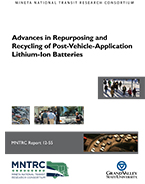Abstract:
Increased electrification of vehicles has increased the use of lithium-ion batteries for energy storage, and raised the issue of what to do with post-vehicle-application batteries. Three possibilities have been identified: 1) remanufacturing for intended reuse in vehicles; 2) repurposing for non-vehicle, stationary storage applications; and 3) recycling, extracting the precious metals, chemicals and other byproducts. Advances in repurposing and recycling are presented, along with a mathematical model that forecasts the manufacturing capacity needed for remanufacturing, repurposing, and recycling. Results obtained by simulating the model show that up to a 25% reduction in the need for new batteries can be achieved through remanufacturing, that the sum of repurposing and remanufacturing capacity is approximately constant across various scenarios encouraging the sharing of resources, and that the need for recycling capacity will be significant by 2030. A repurposing demonstration shows the use of post-vehicle-application batteries to support a semi-portable recycling platform. Energy is collected from solar panels, and dispensed to electrical devices as required. Recycling may be complicated: lithium-ion batteries produced by different manufacturers contain different active materials, particularly for the cathodes. In all cases, however, the collecting foils used in the anodes are copper, and in the cathodes are aluminum. A common recycling process using relatively low acid concentrations, low temperatures, and short time periods was developed and demonstrated.
Publications:
Authors:
CHARLES STANDRIDGE, PH.D.
Dr. Charles R. Standridge is the Associate Dean of the Seymour and Esther Padnos College of Engineering and Computing at Grand Valley State University, in Allendale, MI, where he is responsible for advising services, K-12 outreach activities, and the Department of Occupational Safety and Health. He led the technical work on the Lake Michigan Wind Assessment project, the goal of which was to examine the wind energy potential in Lake Michigan, and is active in curriculum development in the energy systems area. Dr. Standridge received a Bachelor of Science degree in Computer Science from Washington University in St. Louis, and his Master of Science and Ph.D. degrees in Industrial Engineering/Operations Research from Purdue University.
LINDSAY CORNEAL, PH.D.
Dr. Lindsay Corneal is an Assistant Professor in the School of Engineering at Grand Valley State University. She led the recycling process development areas of this project, and has been active in developing curricula concerning materials for energy systems. She earned a BASc (Applied Science) in Mechanical Engineering with a Materials option from the University of Windsor (Canada), an MBA from Lawrence Technological University, and a Ph.D. in Materials Science & Engineering from Michigan State University. She also spent six years as a product engineer at DaimlerChrysler (now Chrysler, LLC) where her main responsibility was the power steering system for the Ram pickup truck.
NICHOLAS BAINE, PH.D.
Dr. Nicholas Baine is an assistant professor in the School of Engineering at Grand Valley State University. He led the repurposing demonstration area of this project, and is active in freshman instruction as well as electrical controls. He earned his BSEE and M.S.E. in Electrical Engineering from Wright State University, and continued on to complete a Ph.D. in engineering, with a focus on controls and robotics. Prior to joining Grand Valley, he worked with the Air Force research laboratory in both the materials and sensors directorates, where he specialized in laboratory automation and electronic navigation and avionics research.


